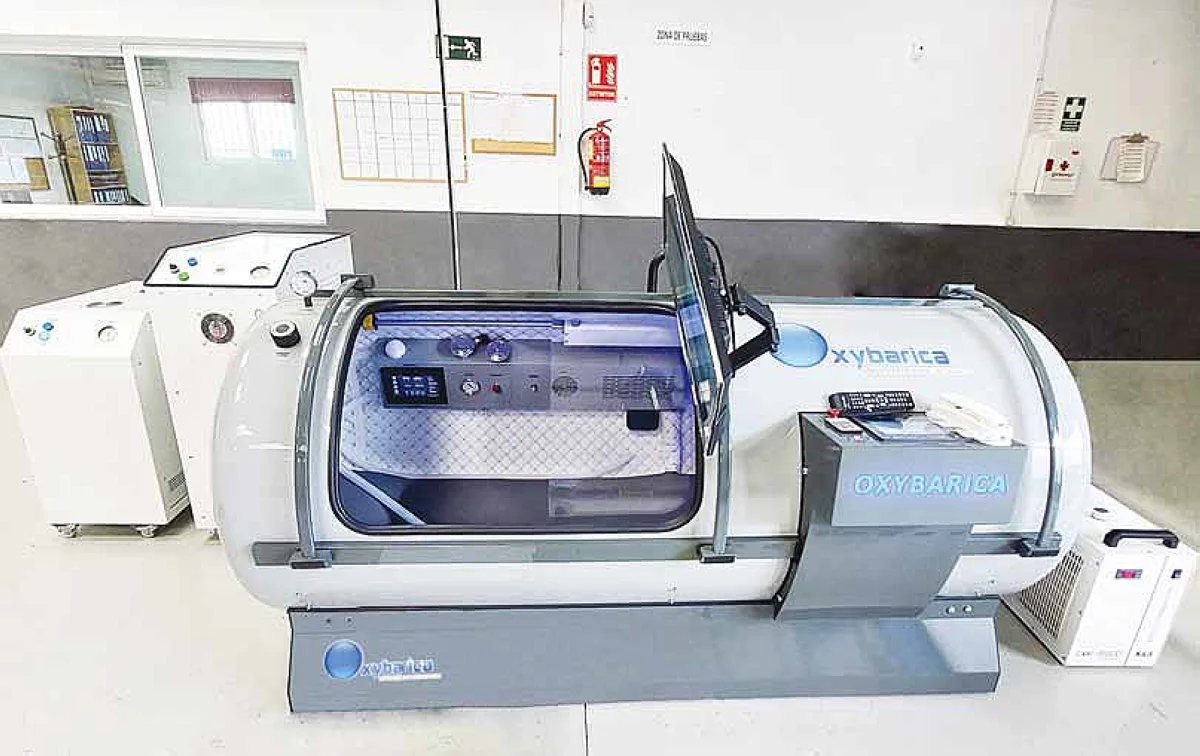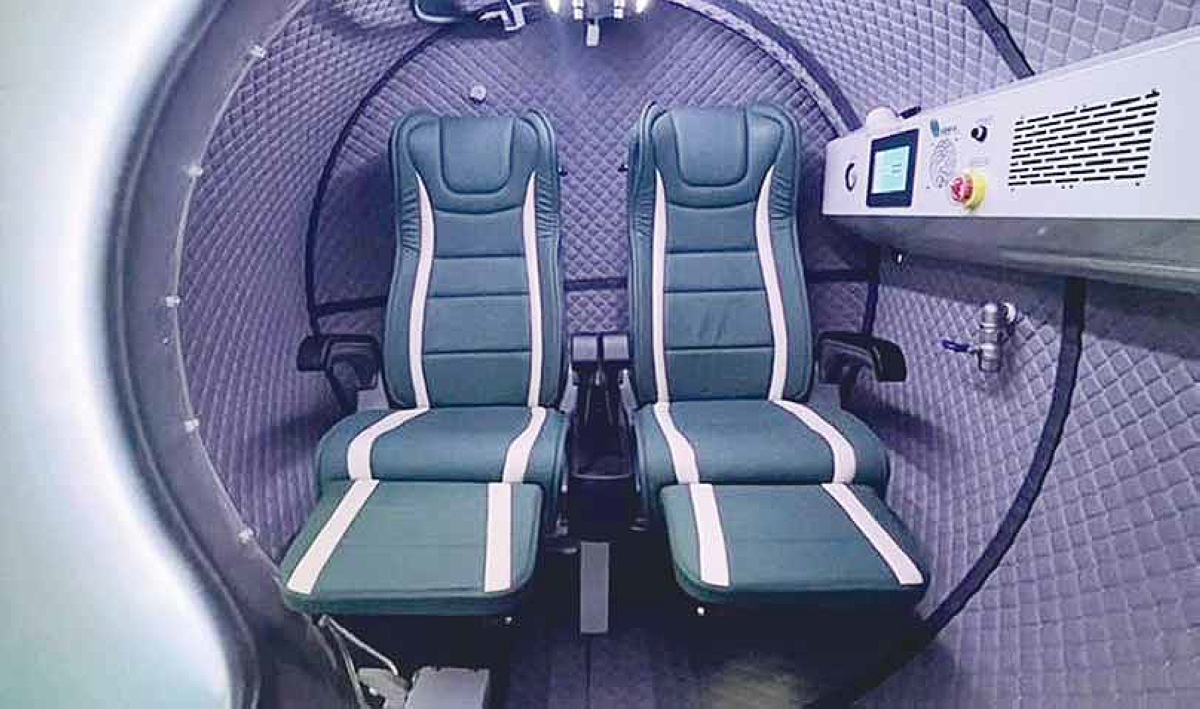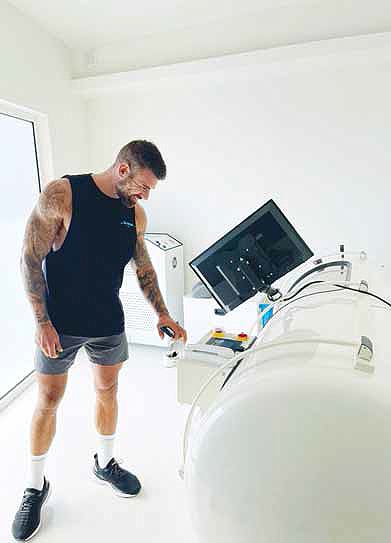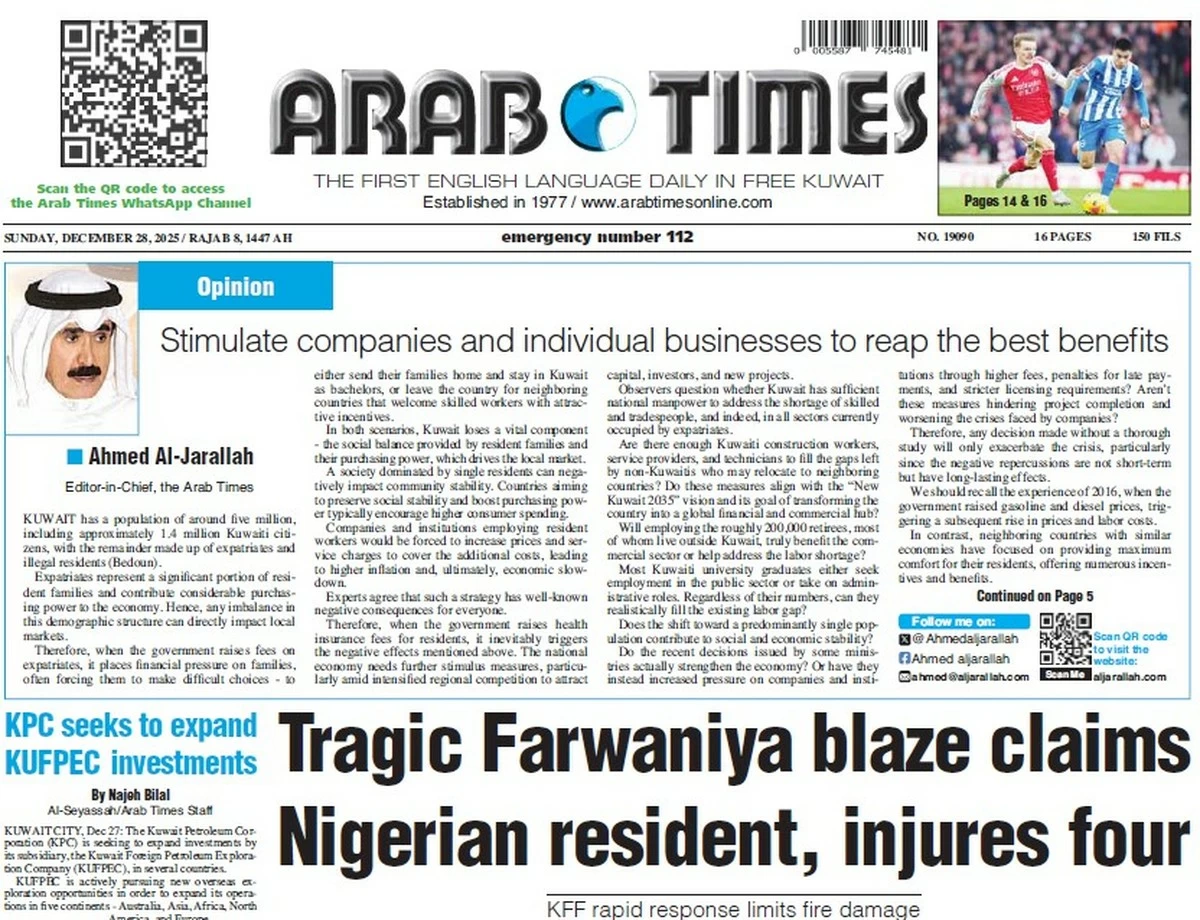26/09/2024
26/09/2024

OXYBARICA aims to transform healthcare in the Middle East with innovative Hyperbaric Oxygen Therapy (HBOT) solutions, enhancing patient care and wellness.
Hyperbaric therapy aids manage diabetes complications, injuries
OXYBARICA a forward-thinking leader poised to revolutionize the healthcare landscape in the Middle East with the advanced field of Hyperbaric Oxygen Therapy (HBOT) and committed to enhancing patient care and promoting wellness dedicated to bringing cutting-edge HBOT solutions is looking to make a foray into the Middle East region to address a growing demand for innovative and effective treatments. By leveraging state-of-the-art equipment and adhering to the highest standards of safety and efficacy, Oxybarica aims to provide transformative therapeutic options for a range of conditions, from chronic wounds and infections to sports injuries and beyond.
At Oxybarica, the company representative, Ricardo Algaba says, “Our mission is to elevate the standard of care in the Middle East through the integration of Hyperbaric Oxygen Therapy into mainstream medical practice. We are excited to collaborate with healthcare providers and stakeholders to foster a healthier future, driven by innovation and excellence in therapy.” In an exclusive interview with the Arab Times newspaper he says, “We are thrilled to introduce Oxybarica to the region, particularly to Kuwait, since our team combines deep expertise in medical technology with a profound understanding of regional healthcare needs to deliver HBOT solutions that not only meet but exceed expectations.

OXYBARICA’s Hyperbaric Oxygen Therapy (HBOT) chamber for two.
Arab Times: Can you provide an overview of the benefits of hyperbaric oxygen therapy?
Ricardo Algaba: Hyperbaric oxygen therapy (HBOT) is a medical treatment in which patients breathe pure oxygen in a pressurized chamber at levels higher than normal atmospheric pressure. This increases the amount of oxygen in the blood and tissues, promoting a range of health benefits such as acceleration of wound healing, reduction of inflammation and edema, improvement in sports injury recovery, treatment of severe infections, improvement in brain function and neuroprotection, detoxification from carbon monoxide and poisoning, support in radiotherapy, improvement in overall health and wellbeing, treatment of decompression sickness and promotion of tissue and blood vessel regeneration. HBOT enhances the body’s ability to heal wounds, particularly those that are difficult to treat, such as diabetic ulcers, radiation injuries, complex surgical wounds or severe infections, the increase in oxygen promotes tissue regeneration and the formation of new blood vessels (angiogenesis), which accelerates the healing process. High-pressure oxygen helps reduce swelling and inflammation in various conditions, such as sports injuries or trauma.
The additional oxygen supply promotes a controlled inflammatory response, which can help relieve pain and stiffness. Athletes use HBOT to speed up the recovery from muscle injuries, sprains, and fractures. The increase in oxygen in damaged tissues enhances the ability of muscles and bones to repair themselves and reduces recovery time. HBOT can help combat resistant bacterial infections by improving immune function and enhancing the effectiveness of certain antibiotics. It is particularly useful in cases of — Anaerobic bacterial infections (such as tetanus or gas gangrene) and Chronic infections like osteomyelitis (bone infection). Hyperbaric therapy can benefit patients who have suffered from Head trauma, Stroke (CVA), Hypoxic brain injuries (lack of oxygen).
By increasing brain oxygenation, it promotes neuronal recovery, improves cognitive function, and reduces cellular damage. HBOT is a standard treatment for carbon monoxide poisoning as it helps to quickly eliminate the gas from the body and restore normal function to the affected tissues. For patients who have received radiotherapy, HBOT can be beneficial in treating complications such as Radiation necrosis (tissue damage caused by radiotherapy) and Damage to soft tissues and bones due to prolonged radiation exposure.
Although not clinically proven for all applications, many people have experienced improvements in — physical capacity and endurance, immune system function and energy and mental clarity, making some consider it useful for enhancing overall well-being. Divers who experience decompression sickness after a rapid ascent can benefit from HBOT. The therapy helps reduce gas bubbles in the bloodstream and tissues, mitigating the dangerous symptoms of this condition. HBOT promotes angiogenesis (formation of new blood vessels) and the regeneration of damaged tissues, which is crucial for the healing of chronic wounds and vascular diseases. Common Conditions Treated with HBOT include sports injuries, diabetic ulcers and diabetic foot, chronic infections (such as osteomyelitis), gangrene, radiation injuries, carbon monoxide poisoning and decompression sickness

A person examines the OXYBARICA’s HBOT chamber
AT: What inspired your interest in expanding your business into the Middle East?
RA: Expanding my hyperbaric chamber business into the Middle East holds great potential due to the growing demand for advanced medical treatments, developing healthcare infrastructure, increasing chronic diseases, and the high purchasing power of the population. With the rising importance of medical tourism and government support for health innovation, the region provides a fertile ground for growth and success for your business.
AT: Which countries in the Middle East do you consider key markets for your services and why?
RA: United Arab Emirates — Dubai and Abu Dhabi are leaders in medical tourism and wellness; both local and expatriate populations can afford advanced treatments; they offer tax incentives for international businesses. Saudi Arabia: massive investments in healthcare, focusing on advanced medical technologies; growing demand for treatments like hyperbaric therapy for chronic complications; wealthy population seeking premium medical care.
Qatar: Qatar invests in advanced healthcare infrastructure, such as Sidra Medicine; the population can access cutting-edge treatments.
Kuwait: Kuwait offers free healthcare to its citizens and is modernizing its healthcare infrastructure; similar to other Gulf countries, there is a demand for treatments for chronic wounds and diabetes complications; Kuwait also has a strong economy and a population seeking advanced medical services.
Bahrain: Bahrain is positioning itself as a medical tourism center in the Gulf; the government is expanding medical infrastructure and promoting investment in advanced technology; although smaller than other Gulf countries, Bahrain has a population with access to high-quality healthcare services. These five countries offer an ideal combination of economic growth, favorable policies, and increasing demand for advanced medical technology, making them key markets for expanding a hyperbaric chamber business.
Kuwait: Kuwait offers free healthcare to its citizens and is modernizing its healthcare infrastructure; similar to other Gulf countries, there is a demand for treatments for chronic wounds and diabetes complications; Kuwait also has a strong economy and a population seeking advanced medical services.
Bahrain: Bahrain is positioning itself as a medical tourism center in the Gulf; the government is expanding medical infrastructure and promoting investment in advanced technology; although smaller than other Gulf countries, Bahrain has a population with access to high-quality healthcare services. These five countries offer an ideal combination of economic growth, favorable policies, and increasing demand for advanced medical technology, making them key markets for expanding a hyperbaric chamber business.
AT: What challenges do you anticipate when entering the Middle Eastern market and how do you plan to overcome them?
RA: In terms of regulatory and bureaucratic barriers we sense complex licensing and permit processes. However, the solution lies in collaboration with local consultants and partners familiar with regulations. However, some of the challenges may rest in cultural differences — language and business practices. However, this may be overcome by training our team on local culture and hiring local staff to facilitate relationships. In terms of competition, I can say we have to compete with established local and foreign companies which can be overcome by differentiating our product with advanced technology and strong aftersales service; establishing partnerships with hospitals, distributors, or governments, and participate in industry events.
AT: How do you plan to adapt your marketing and operational strategies to fit the culture and dynamics of the Middle Eastern market?
RA: Cultural Customization — Adapt messages to respect and reflect local values and sensitivities. Use Arabic in communications to better connect with the population. Ensure content avoids sensitive topics and focuses on positive aspects like health and wellness. Use of Local Influencers — Collaborate with influencers or recognized personalities in health and wellness to build trust in your product. Local influencers can help reach specific audiences and build credibility. Marketing Channels — Invest in digital advertising on popular social media platforms such as Instagram, Snapchat, and TikTok, which are widely used in the region. Also, consider traditional media such as television and radio, especially in countries where they still have a significant impact. Pricing Strategy — Adapt pricing structures to cater to both high-purchasing-power markets (such as the UAE and Qatar) and more price-sensitive segments. Offer different service levels or packages to meet the economic needs of various customers. Local Partners — Establish partnerships with distributors and local partners already established in the healthcare sector. This will help overcome cultural and operational barriers and leverage their market knowledge to facilitate entry and expansion.
AT: What market research have you conducted on the demand for hyperbaric oxygen therapy in the Middle East?
RA: The Middle East, especially the UAE and Qatar, is experiencing growth in medical tourism. These countries are investing in advanced healthcare infrastructure, attracting international patients seeking innovative treatments, including hyperbaric chambers. The region is also seeing an increase in demand for wellness and recovery treatments, including hyperbaric therapy, used for rejuvenation and physical performance enhancement.
The prevalence of diabetes in the Middle East is high, with particularly high rates in countries like Saudi Arabia and the UAE. Hyperbaric chambers are useful for treating complications such as diabetic ulcers and healing issues. With the rise in popularity of sports and sporting events in the region (such as the World Cup in Qatar), there is increased demand for treatments that aid in injury recovery, including hyperbaric therapy. The Gulf countries are investing in modernizing their healthcare systems.
The UAE and Saudi Arabia are at the forefront with state-of-the-art hospitals and clinics and are open to new technologies and medical treatments. Cities like Dubai and Abu Dhabi already have advanced medical centers that may be interested in incorporating hyperbaric chambers as part of their treatment offerings. The hyperbaric chamber market in the Middle East is growing but not as saturated as in other regions. This presents a good opportunity to introduce new technologies if market entry is managed appropriately. Compliance with local health regulations and obtaining necessary certifications is crucial.
Approval and compliance may vary from country to country, so it is important to work with local consultants and understand specific requirements. Reviewing market studies and industry reports on healthcare in the Middle East can provide more detailed data on the demand for hyperbaric chambers. Sources such as Frost & Sullivan, Markets and Markets, and Grand View Research often publish reports on market trends and demand in the medical equipment sector. Conducting interviews with doctors and hospital administrators in the region can offer qualitative insights into the demand and treatment needs that hyperbaric chambers could address.
The UAE and Saudi Arabia are at the forefront with state-of-the-art hospitals and clinics and are open to new technologies and medical treatments. Cities like Dubai and Abu Dhabi already have advanced medical centers that may be interested in incorporating hyperbaric chambers as part of their treatment offerings. The hyperbaric chamber market in the Middle East is growing but not as saturated as in other regions. This presents a good opportunity to introduce new technologies if market entry is managed appropriately. Compliance with local health regulations and obtaining necessary certifications is crucial.
Approval and compliance may vary from country to country, so it is important to work with local consultants and understand specific requirements. Reviewing market studies and industry reports on healthcare in the Middle East can provide more detailed data on the demand for hyperbaric chambers. Sources such as Frost & Sullivan, Markets and Markets, and Grand View Research often publish reports on market trends and demand in the medical equipment sector. Conducting interviews with doctors and hospital administrators in the region can offer qualitative insights into the demand and treatment needs that hyperbaric chambers could address.
AT: What differentiates your HBOT services from existing options in the Middle East?
RA: Our hyperbaric chambers feature state-of-the-art technology to ensure optimal performance and superior treatment experiences. This includes advanced pressure control systems, precise monitoring, and automatic adjustments for enhanced safety and efficacy. We use the highest quality materials in constructing our chambers to ensure durability and safety. Our chambers are designed to withstand extreme conditions and guarantee a long lifespan, meeting the most rigorous international standards. Our chambers are designed with a focus on patient comfort, offering a spacious and well-ventilated environment. They also include advanced safety features such as communication systems and emergency protocols to ensure a safe and comfortable treatment experience. The chambers we provide are certified with international quality and safety standards, ensuring they meet the highest industry benchmarks. This guarantees that our equipment is reliable and approved for use in demanding clinical environments. We conduct rigorous and regular maintenance of our chambers to ensure they operate under optimal conditions. Additionally, we are committed to continuously updating our equipment to incorporate the latest technological innovations and design improvements.
AT: How do you plan to educate potential clients and healthcare providers in the region about the benefits of HBOT?
RA: Host seminars and workshops at medical centers, hospitals, and health conferences. Invite HBOT experts to present case studies, recent research, and patient testimonials. Offer training courses for doctors and healthcare professionals, highlighting the clinical applications of HBOT and how it can be integrated into their current practices. Collaborate with hospitals and clinics to conduct pilot studies or demonstration programs that allow healthcare professionals to experience the benefits of HBOT firsthand. Work with universities and research centers to develop educational materials and conduct studies on HBOT that can be published and shared with the medical community. Create educational materials in Arabic and English that clearly explain the benefits, applications, and scientific evidence of HBOT. Distribute these materials in clinics, hospitals, and health centers. Publish articles and studies in local medical journals and specialized health blogs to reach a broader audience. Participate in health fairs and exhibitions in the region to showcase your equipment and provide presentations on the benefits of HBOT. These events are excellent opportunities to network with potential providers and clients.
AT: Are there specific medical conditions or wellness trends in the Middle East that align well with your therapy services?
RA: With a high prevalence of diabetes in the region, there is a significant need for treatments addressing complications such as diabetic ulcers. HBOT can be beneficial in promoting healing and managing chronic wounds. There is a growing interest in treatments for sports-related injuries due to the increasing number of sporting events and activities. HBOT can aid in quicker recovery and enhance athletic performance. There is a rising trend towards wellness and physical performance improvement. HBOT fits well with this trend by offering advanced recovery and rejuvenation options, which can attract individuals seeking to enhance their overall health and performance.
AT: Are you looking to partner with local health providers or institutions in the Middle East?
RA: Yes, we are open to collaborating with local health centers and institutions. Establishing partnerships can help us integrate our services into the local healthcare system and provide valuable benefits to patients.
AT: How do you plan to build trust and credibility with local patients, considering cultural differences and medical standards?
RA: We plan to build trust and credibility by highlighting the scientific studies and clinical evidence supporting the effectiveness of HBOT; by providing state-of-theart hyperbaric chambers that meet international standards for quality and safety and understanding and respecting local cultural norms and medical practices to ensure our services are well-received and aligned with local expectations.
AT: Have you had discussions with any regulatory authorities in the region regarding approvals and compliance?
RA: No, we have not yet engaged with regulatory authorities regarding the approval and compliance of hyperbaric chambers in the region. This will be an essential step to ensure that our products meet local regulations and standards.
AT: What is your pricing strategy for the Middle Eastern market, and how does it compare with your offerings in Spain?
RA: Our pricing strategy will generally align with the prices in Spain, with adjustments made primarily for transportation costs. We understand that the purchasing power in Spain may differ, but our aim is to maintain consistency in pricing while accommodating regional logistics.
AT: Do you plan to open physical clinics in the region or will you focus on partnerships and collaborations?
RA: Currently, our focus is on selling our high-quality chambers in the Middle East. However, in the future, we may consider collaborations to establish a dedicated HBOT center if there is sufficient demand and opportunity.
AT: What are your long-term growth objectives for the Middle East, and how does this region fit into your global expansion plan?
RA: At this stage, our goal is to introduce our HBOT chambers to the Middle Eastern market and allow many people to benefit from them. Long-term, we hope to expand our presence in the region and explore further growth opportunities as we gain traction and build relationships.
AT: How do you see HBOT contributing to the healthcare landscape in the Middle East?
RA: HBOT can make a significant impact on the healthcare landscape in the Middle East by offering effective treatments for complications associated with chronic conditions like diabetes; accelerating recovery from sports injuries and improving athletic performance; complementing the growing focus on wellness and physical rejuvenation; contributing to the diversification and modernization of healthcare services in the region and helping to prevent complications and reduce costs associated with chronic conditions and prolonged treatments. In summary, HBOT can strengthen the healthcare system in the Middle East by providing advanced solutions for chronic conditions, supporting sports recovery, meeting the demand for wellness treatments, and enhancing medical infrastructure.
AT: Are there any Corporate Social Responsibility (CSR) initiatives you plan to launch in the region to promote health and wellness?
RA: At this moment, we do not have specific CSR initiatives planned. However, we are open to exploring opportunities to contribute positively to health and wellness in the region through community engagement and support programs in the future.
For more information contact Ricardo Algaba at Oxybarica; Av. de la Industria, 55, 45200 Illescas, Toledo, España [email protected] Mobile: +34 615246730
For more information contact Ricardo Algaba at Oxybarica; Av. de la Industria, 55, 45200 Illescas, Toledo, España [email protected] Mobile: +34 615246730
By Paulo Francisco X. Fernandes Arab Times/Al-Seyassah Staff


